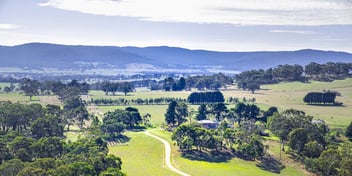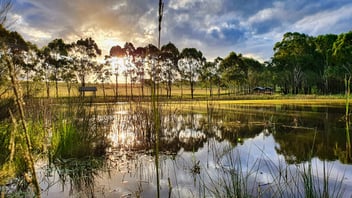How this water utility became an integral part of the circular economy
Urban Utilities has developed an expanded resource recovery (ERR) model that can transition its function from compliance to an integral player in the region’s circular economy.
The transition to a circular economy is already in motion and demanding organisational and system-wide change. Previously established linear supply chains are being disrupted and replaced by new circular models enabled by cross-industry collaboration promoting cross-sector flow of water, energy and raw materials.
Urban Utilities is actively navigating this change by proposing an ERR model that transitions resource recovery from a function for compliance to a commercial waste processing business. The ERR model adds value to South East Queensland’s (SEQ) circular economy by establishing collaborative partnerships to create new supply chains for sustainable production of water, energy and nutrients.
Urban Utilities has established resource recovery centres (RRC) at Luggage Point and Oxley Creek. Resource recovery operations currently involve processing sewage, commercial trade waste and liquid organic waste substrates (from commercial customers) using anaerobic digestion. This process generates three key resources: recycled water, nutrient-rich biosolids and energy-rich biogas.
The utility has existing recycled water schemes servicing both on-site water demand and commercial customers. The biosolids are used as a soil conditioner for agricultural purposes and the biogas is converted to heat and electricity for on-site reuse.
A recent shift in Urban Utilities’ operating environment has created a window of opportunity to expand resource recovery to include fats, oils, grease (FOG) and food waste through anaerobic co-digestion (ACoD).
The landfill levy, resource recovery grants and increased stakeholder focus on the circular economy has opened up organic waste supply driven by landfill avoidance. At the same time, the End of Waste Code for biosolids is driving water utilities to seek alternative sludge management solutions in the face of substantial cost increases. The opportunity also supports Urban Utilities’ broader strategic goal of demonstrating environmental leadership and adding social and economic value to its customers and community.
The crux of the ERR model is using the existing capabilities, technological advances and the available market opportunity to become a valuable player in the regional circular economy. The model involves ACoD of FOG, food waste and imported sludge; and optimal use of downstream products (biogas, biosolids and nutrient rich sidestreams).
ACoD of FOG, food and imported sludge
The ACoD of high strength liquid organic waste (HSLOW) will be expanded to process additional organic material sourced from commercial precincts and municipalities. Enhanced infrastructure and establishment of strategic partnerships are key requirements to divert organic waste from landfill for conversion into high value products for reuse, and positions Urban Utilities as an integral part of the circular economy value chain.
Highest and best use of downstream products
Recognising the material shift required for a transition to ERR, the model includes the need to effectively use the increased biosolids, biogas and the nutrient-rich centrate.
Biosolids: A pelletisation technology, Enerpel by Moxiepel Pty Ltd is currently being trialled at Luggage Point RRC for biosolids management. This converts biosolids into dry pellets for reuse either as a fertiliser or energy source, achieving significant biosolids volume reduction in the process (Figure 1).
The technology also has the potential for direct sludge stabilisation as well as the potential to be tailored to produce a mixed pellet incorporating other organics such as sorghum, sawdust and chicken manure. This technology provides a step-change in biosolids management and flexibility in end-use markets based on feedstock diversity, calorific value and nutrient content of the produced pellet.
Higher value biogas utilisation: The ERR model considers multiple options for biogas including cogeneration expansion, biogas purification and upgrading to a natural gas equivalent product, or production of a derivative product such as hydrogen or methanol. The model will adopt the preferred option based on an assessment of technical and market risks, which is different for each option.
Centrate nutrient recovery: A limiting factor for ERR is the nutrient-rich centrate sidestream returned to the treatment plant. ERR considers nutrient recovery for reuse rather than removal. Technology assessments include ammonia stripping and recovery options.
Each of the technologies incorporated within Urban Utilities’ ERR model are established processes successfully implemented (or undergoing pilot trials) in facilities overseas. While each individual technology is technically proven, the unique aspect of Urban Utilities’ ERR proposal is the novel plant-wide integrated approach and the focus on industry partnerships within the local market (Figure 2).
To date, much of the resource recovery focus globally has been on energy recovery driven by financial and legislative incentives. Co-digestion of organic waste to increase energy recovery has been a strategy readily employed at full-scale throughout the United States (US), Canada and Europe. Additional legislative incentives such as the prohibition of organic waste from landfill have also promoted the ACoD strategy and stimulated an organic waste market in several European countries.
Biogas utilisation strategies have been heavily driven by national energy policy. For example, in Austria, a focus on achieving renewable electricity targets has promoted the conversion of biogas into electricity and incentivised co-digestion facilities, such as the Strass Sewage Treatment Plant near Innsbruck, to become a net power producer.
Conversely in Norway, where renewable electricity targets are already achieved through hydropower, treatment plants such as BEVAS in Oslo have been upgrading biogas into transportation fuel and selling it to the public transport sector for over a decade.
Less development has been made worldwide in commercialising nutrient recovery due to lack of financial and political drivers, restrictive regulations on waste-derived products, and competing inorganic fertiliser subsidies creating a competitive market.
Despite these barriers, 22 operating plants across the US, Canada and Europe are currently recovering nitrogen and phosphorus as a commercial commodity from wastewater through a controlled struvite crystallisation process.
Across the globe, utilities are rethinking wastewater management. Urban Utilities is joining this movement with a holistic approach that leverages existing assets and combines established technologies for the integrated recovery of water, energy and nutrients through the production of viable commercial products. The model enables Urban Utilities to become an integral part of SEQ’s circular economy through increased organic waste processing and collaborative partnerships.



